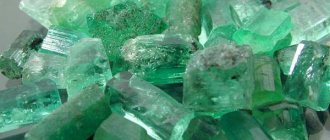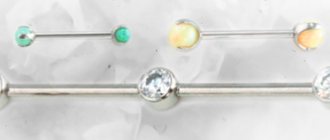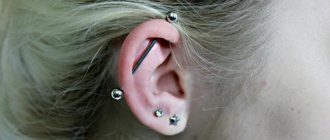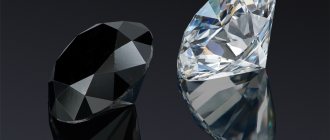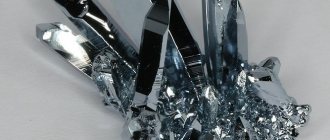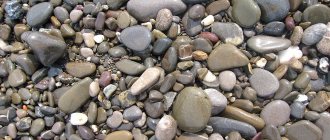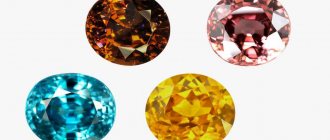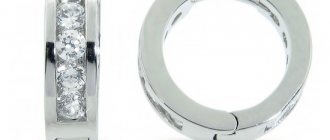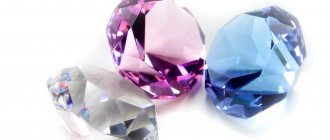When visiting jewelry stores, we listen with admiration to the smooth speeches of sellers who easily operate with all kinds of terms, usually of foreign language origin. And often, behind a series of these words, the meaning of statements slips away.
For example, do you clearly feel the difference between a necklace and a necklace? And can you explain in a nutshell how these jewelry differ from beads? Most likely, you will experience some difficulties with the wording and description of these decorations. All of them are worn around the neck, this is understandable. What's the difference?
Beads as they are
Let's start with the simplest thing - beads. Of the entire above-mentioned glorious family, these are the most “aged” and well-deserved decorations. And this is understandable: you can create the simplest beads without even having jewelry skills. We take a thread, thread it into a needle, string rowan berries - and here you have bright children's beads. Simple and short-lived, but still formally these are beads!
To summarize: beads are jewelry worn around the neck, consisting of beads (usually round or oval) of approximately the same color. In this case, it is fundamentally important that the beads are simply strung on a thread, fishing line or other base through holes drilled in them. The presence of a frame automatically transforms the beads into the category of necklaces.
The category of beads sometimes also includes jewelry with an alternative method of connecting beads. For example, they can be mated to each other using metal hooks or fused to a thread.
Beads can be made from precious or semi-precious stones, all kinds of beads of different sizes, wood and even metal! They can be laid in one or several rows and vary significantly in length, and short versions may have a clasp.
Formally, beads are considered a simpler and more democratic decoration for every day. However, there are exceptions: who would call a string of natural pearls that classically harmonizes with a little black dress “simple”?
What is a necklace?
The word “necklace” is of original Slavic origin. Do you know what our ancestors called the throat? That's right: “mouth” (yes, like a cannon or a volcano). That is, the necklace is what is around the throat. In Ancient Rus', this was often the name given to the collar part of the armor and, accordingly, the neck of cattle. No romance or aesthetics, right?
Now a necklace is a piece of jewelry (or costume jewelry) on a rigid hoop or chain, with inserts of precious and semi-precious stones, amber, coral, ivory, wood, various types of glass, plastic and others like them. A neck chain of decent volume and/or complex weaving (for example, Byzantium) can also rightfully be called a necklace. The necklace can have different lengths, be single-row or multi-row.
In medieval Rus', among the nobility there was a fashion for complex, heavy necklaces made of gold with a lot of precious stones. Open necks and shoulders were not in trend at that time, so such jewelry was worn on top of clothes, often fastened to it.
Silver necklace
Gold necklace
A necklace looks different: in appearance it can be close to beads or a necklace. Moreover: different sources give different definitions of this term. However, most of them agree on one thing: the elements of the necklace are more or less equal in size.
Collar
Up to 35 cm
Since the Middle Ages, the collar has been a man's adornment, a symbol of power and belonging to a knightly order. Externally, the collar was a chain with large links, which ends with the same large pendant, which could serve as an order, or a pendant with a family emblem or heraldic symbols.
Today, a collar is a flat, wide “collar” up to 35 cm long. Sometimes its width is almost equal to the length of the neck of the owner of such a necklace. Recently, a variety of collars has become popular, repeating the appearance of a shirt collar, decorated with precious, semi-precious stones or simply beads.
Advertising - Continued below
What is a necklace?
A sensitive ear will immediately detect foreign notes in this word, which is very attractive from a female point of view (and ruinous from a male point of view). And rightly so, because it came from a French (and originally from Latin) word, meaning something worn around the neck (including a collar). In essence, this is the same necklace, but with a French pronunciation.
In principle, from the point of view of most jewelers and stylists, a necklace is a special case of a necklace, but of a more complex shape. The necklace looks more elegant and rich thanks to a clearly defined central part (usually only a laconic chain or hoop remains at the back). It is worn on a bare neck, which places certain demands on clothing. Due to the short length, a clasp is required.
In the classic version, this is a highly artistic piece of jewelry, but there are exceptions. Now there are jewelry that can formally be considered a necklace, but they are worn over clothes even with everyday looks: a long chain length, affordable materials like glass, semi-precious stones, leather and wood, but a pronounced central part. So what is it, a choker or a necklace? Often, even world-famous stylists find it difficult to classify.
Necklaces came to Russian soil during the era of the great reformer Tsar Peter I. It was then that bare shoulders and dizzying necklines came into fashion. How not to emphasize the beauty of a necklace with diamonds, sapphires, emeralds or pearls?
There are several recognizable varieties of necklaces:
- Riviera. A sophisticated and elegant choker or necklace, usually consisting of elements that fit very tightly together. The result is a piece of jewelry that looks almost monolithic, but lies softly on the collarbones and seems to “flow” down them like a stream. An aristocratic, sophisticated option, revealed in all its glory only with evening dress.
Riviera necklace with cubic zirconia
- Clasp. A distinctive feature of this type of jewelry is the location of the clasp. It is positioned in front and in itself represents an accented decorative element (in the classical reading - a large stone or an enamel miniature).
One of the most famous clasp necklaces that belonged to Princess Diana
- Slavage. The etymology of this captivating French word is not so romantic: literally translated, it means “slavery.” These necklaces often consist of chains decorated with precious stones and enamel inserts. The second option is a strip of fabric (usually velvet) with decorative elements attached to it. The main condition is a fairly tight coverage of the neck, like a slave collar.
Squalage necklace
- Plastron. And again, a word of French origin, literally translated meaning “bib.” This is the name for voluminous jewelry that covers a significant part of the chest like a shirtfront. Due to the high consumption of material in jewelry, plastrons exist in the form of very expensive single copies.
Plastron necklace by Harry Winston
Plastron is a very stylish decoration that can be used to complement many current outfits. With the participation of the plastron, you can play up the bow in the Egyptian, African or Greek style, as well as brilliantly realize the look in boho.
How to make a necklace from beads or pearls with your own hands
Faux pearl jewelry looks beautiful in almost any setting. A light, airy necklace of small width is suitable for the office; for an evening out, you can make a necklace of garnet and pearls or combine pearls with small beads
Creative thinking and harmonious colors will allow you to isolate your image, highlight it from the crowd and focus attention on a beautiful neck or well-groomed décolleté area
Silver necklace with pearls (go to SUNLIGHT catalogue)
Making a simple pearl necklace with your own hands is not difficult; it is important to have the necessary materials available. It can be either the same type of pearl or a variety of pearls
Beginners can start with the simplest techniques and patterns, and then, expanding their horizons, replenish their piggy bank with more complex weaving patterns, creating new interesting jewelry. By analogy with pearls, you can make a necklace from beads with your own hands.
You can find a wide variety of master classes of varying degrees of difficulty online. The selected version of the training material allows both a novice craftswoman and an experienced craftswoman to create a beautiful product. By changing the width of the decoration upward, you can create a more complex version.
Master class on making a pearl necklace with your own hands
The image shows that the necklace consists of several patterns, the weaving is done from top to bottom, but can be complemented by an “inner” and “top” pattern. Inexperienced needlewomen can limit themselves to the option of a thin necklace consisting of 1-2 rows. More experienced ones are allowed to add new, more complex weaving options. The number of beads, seed beads, and fishing line varies depending on the individual size of the product.
Necessary materials:
- Czech beads of light shades;
- beads with a gold or silver core;
- beads with an offset center;
- artificial pearls with a diameter of 4 mm;
- fishing line of a suitable color;
- a ready-made lock of a suitable color (gold or silver);
- a needle having a smaller diameter than the holes in beads and pearls;
- pliers.
Prepare the necessary materials: sort the beads and pearls into shallow containers, cut the fishing line with some reserve. If you are working with light beads and pearls, use a dark-colored fabric or craft mat for the work surface and vice versa.
First stage
Legend: white color - Czech beads of light shades; yellow color - beads with a gold or silver core.
- Place eight white beads on the fishing line, starting from the element with the core, and close them by threading the end of the fishing line into the beads with the core, forming a ring.
- Continuing the set, add two Czech beads to the fishing line, one with a core and two Czech beads (five elements in total). Close the beads into a ring, passing the fishing line through the second bead of the previous cycle (see diagram). You get two adjacent closed loops.
- Next, collect five Czech beads and pass the line through the element with the core, closing the second lower loop, as shown in the diagram.
- Repeat the operation from step 2 until you create a chain of eights of the required length.
Second phase
New symbols have been added: small red - Czech beads of light shades; red large - artificial pearls with a diameter of 4 mm.
You begin to form the bottom row with pearl pendants.
- On a separate fishing line you collect three Czech beads, one pearl, one bead with a core (5 elements in total). Fasten the bead to the core (see diagram).
- Then you collect three Czech beads and secure the resulting pendant loop to the seventh Czech bead of the top row, as shown in the diagram.
- Repeat the operation along the entire bottom of the previous row.
For beginners, you can finish the job here by securing the finished lock.
Those who want to complicate the course perform further more complex weaving.
Third stage
New symbols: small lilac - Czech beads of light shades; lilac drop-shaped - beads with an offset center.
The top row of the product should be supplemented in accordance with the arrows indicated in the diagram.
Fourth and fifth stage
The last two stages are designed for experienced needlewomen and are performed according to the presented schemes. Below is a breakdown of the new designations.
Small blue – Czech beads of light shades; blue large - beads with a gold or silver core.
Green small - Czech beads of light shades; green drop-shaped - beads with an offset center.
What is the difference between a choker, a necklace and beads?
Now let's summarize the above, focusing on the most classic examples of the above-mentioned jewelry. So:
- Design. Beads are a soft structure consisting of beads of approximately equal size, strung on a thread or fishing line without a frame. The necklace suggests a different combination of elements. A necklace differs from a necklace by its visually expressed central part (color, size, length of pendants, etc.).
- Materials. Necklaces and beads can be made from affordable materials (including glass and plastic). The necklace is gold and silver, precious (in extreme cases, semi-precious) stones and other expensive materials (pearls, Murano glass, Swarovski crystals, amber, ivory, and so on).
- Purpose. In the classical interpretation, a necklace differs from a necklace and beads in that it is a highly artistic piece of jewelry intended for special occasions. A precious necklace is only appropriate with evening wear. Necklaces and beads, for the most part, are more democratic: even a string of pearls or amber is quite suitable for everyday office outfit. And there are no restrictions at all for walking around the city!
- Gender. A necklace is a typically feminine piece of jewelry, while beads (don’t be surprised!) and even necklaces can also exist in a masculine version. An intermediate position is occupied by men's chokers and rosaries made of beads (wooden, metal, onyx, agate, malachite and others like them) with pendants in the form of symbols of faith, animal fangs, sacred symbols and so on.
- Price. Considering that a classic necklace is a piece of jewelry, often with large stones, then its cost is expected to be higher. But this is also a convention: a necklace made of large natural pearls will also cost a fortune.
In English, both beads and necklaces are called by one word - “necklace”. The term “beads” is used for beads and beaded jewelry of any type. How much easier it is for the natives of Foggy Albion, isn’t it?
Chain - a universal decoration
The chain is one of the basic jewelry, because it can be worn separately or with pendants, and the latter can be changed.
This product consists of metal links interlocked with each other. These links can have different shapes and interlock with each other in different ways. Jewelers know well how shell weaving differs from anchor or cord weaving. But there are also Byzantine, Persian, “rollo”, “lav”, “snail”, “snowball” and dozens of others. So there is no need to say that the chain is boring or monotonous.
In addition, chains can vary in length, size of links and material from which they are made.
Thin chain
Thick chain
By the way, the chain can be the basis of a necklace, which will be discussed later.
A little about length
Necklaces, beads and necklaces can also vary in length. It is customary to distinguish several options for the length of necklaces, which have their own names:
- Collar. This is the shortest piece of jewelry, with a length of about 30-35 cm. Its name, like the word “necklace,” comes from the French synonym for collar. Beads in the collar version practically do not exist, with the exception of variants with a model elastic band, but necklaces and chokers often do.
- Choker. The choker is slightly longer than the collar (35-40 cm). This is the most common length for men's necklaces and women's jewelry necklaces (thanks to Queen Victoria and Coco Chanel). Chokers can be beads, necklaces, chokers and so on. A short string of pearls located on the collarbones and above is also a choker.
- Princess. The most common and aristocratic version is 43-48 cm long. Can be worn with a neckline or a slightly unbuttoned blouse, or over clothing. Often such beads are stacked in several tiers. Princess necklaces are quite rare.
- Matine. This is a necklace or beads 50-60 cm long. They are worn mainly over clothes, because a neckline of such depth is almost topless. Necklaces in this length are not produced by the jewelry industry.
- Opera. These are very long beads (66-91 cm) that are worn over clothing. There are no necklaces, let alone an Opera necklace.
- Rope. These are exclusively single-row beads without a lock, consisting of small elements, with a length of 120 cm. They are called the word “Rope”, derived from the English version, translated as “rope”. A very interesting decoration that can be laid in several rows, or can be lowered over clothing to waist level. A universal and democratic decoration that fits perfectly into trendy urban looks.
The original version of the Rope is called the Lariat. These are long string beads (usually made of beads) with open ends. The ends are topped with tassels or other weighted decorative elements and tied with various knots.
Although, what difference does it make to which category this or that decoration belongs? The main thing is that the woman feels like a queen in it, and everything else is minor little things that are not worth attention!
13.04.21

